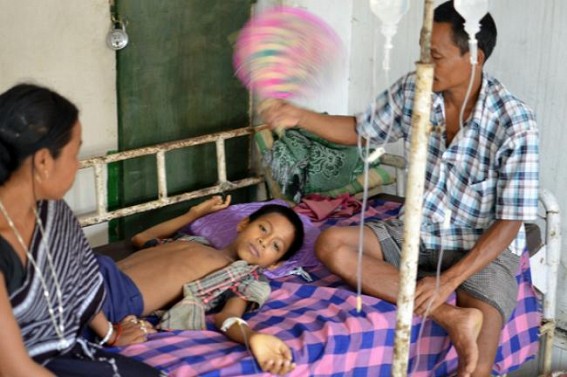TIWN

AGARTALA, December 21 (TIWN): Tripura state once again found itself in the grip of an unprecedented malaria outbreak, ninety-three kilometers from Agartala, in Dhalai District. The cases are reported from villages under the Gandachera sub-division. Though no malaria affected patients were reported to have killed so far, but at least 6 patients detected with malaria fever are currently undergoing treatment at the local hospital. Previous month at least 190 patients were hospitalized, said Gandacherra SDM Bhaskar Das Gupta.
Talking to TIWN today the Gandacherra SDM Bhaskar Das Gupta said that the villages under the Gandacherra sub-division had fallen victim to the malaria outbreak this time. And now the state medical team is conducting health cam along with certain awareness camp at Gandacherra villages. He said that previous month atleast 190 patients detected with Malaria fever were hospitalized and currently around 6 are undergoing treatment at the local hospital.
Adding to that he further informed that the state govt. has recently taken an initiative to construct a letrins at the area. A total of 200 letrins has been constructed at Dumburnagar Block and 100 letrins at Raishyabari Block, said SDM Bhaskar Das Gupta. He also added that the concerned administration is spraying a vaccine at the areas that has fall victim to malaria.
However but it is to be mentioned here that as part of the basic necessities the state govt. had failed to provide the mosquito nets to the families who are recently residing under the Gandacherra sub division.
Earlier during the month of September of this year more than 1, 01,025 people, comprising mainly tribals, have fallen ill with malaria and fever. As on date 69 people have died and more than 31,374 have been infected. Ninety percent of the dead are children who are below the age of 10 years. This is due to malnutrition with low immunity of tribal children. In 2013, also there were 2,561 malaria cases with one death. The ground reality is said to be much higher.
Earlier during the year 2014 as news trickled out about the malaria deaths, a few weeks ahead of the panchayat elections (July 15), the government took a series of decisions: it suspended 50 rural health workers (the lowest tier), reprimanded doctors and cancelled their leaves, and organised health camps. Until July 13, it had organised 4,078 health camps and large-scale sensitisation programmes, and flooded the public health centres (PHCs) with second-generation medicines (the state was declared malaria-drug resistant in 2009) and rapid diagnostic kits (RDK). It sent out DDT (used for vector control) spray teams even to the “inaccessible” mountainous areas, home to Primitive Tribal Groups (PGT) like the Reangs, the Tripuri and the Molsom.
Since many tribals do not complete the full course of drugs, they become drug resistant and are moving reservoirs, once a mosquito bites them, it can infect others. Many malaria cases are reported even in winter because of this phenomenon. As May-June is peak season for jhum cultivation the tribals’ are toiling in fields that are swarmed with mosquitoes the tribals do not wear clothes that fully cover their bodies, hence they are susceptible to mosquito bites.
- Protest in Tripura against Tripura Education Board's Huge Fee Hikes
- Patient Party Alleged 'Punishment Referral' Punishment for Speaking Out at IGM Hospital
- Pakistani Woman Held in Sabroom, Probe Underway
- 150 Mobile Phones Recovered in Sonamura Border Operation
- ABVP Demanded Every Year 'Little' fee hikes for TBSE Exams



